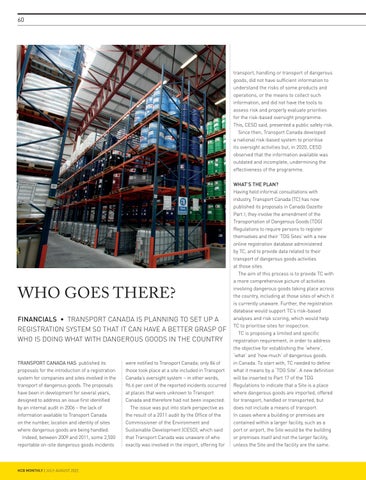60
transport, handling or transport of dangerous goods, did not have sufficient information to understand the risks of some products and operations, or the means to collect such information, and did not have the tools to assess risk and properly evaluate priorities for the risk-based oversight programme. This, CESD said, presented a public safety risk. Since then, Transport Canada developed a national risk-based system to prioritise its oversight activities but, in 2020, CESD observed that the information available was outdated and incomplete, undermining the effectiveness of the programme.
TRANSPORT CANADA HAS published its proposals for the introduction of a registration system for companies and sites involved in the transport of dangerous goods. The proposals have been in development for several years,
were notified to Transport Canada; only 84 of those took place at a site included in Transport Canada’s oversight system – in other words, 96.6 per cent of the reported incidents occurred at places that were unknown to Transport
WHAT’S THE PLAN? Having held informal consultations with industry, Transport Canada (TC) has now published its proposals in Canada Gazette Part I; they involve the amendment of the Transportation of Dangerous Goods (TDG) Regulations to require persons to register themselves and their ‘TDG Sites’ with a new online registration database administered by TC, and to provide data related to their transport of dangerous goods activities at those sites. The aim of this process is to provide TC with a more comprehensive picture of activities involving dangerous goods taking place across the country, including at those sites of which it is currently unaware. Further, the registration database would support TC’s risk-based analyses and risk scoring, which would help TC to prioritise sites for inspection. TC is proposing a limited and specific registration requirement, in order to address the objective for establishing the ‘where’, ‘what’ and ‘how much’ of dangerous goods in Canada. To start with, TC needed to define what it means by a ‘TDG Site’. A new definition will be inserted to Part 17 of the TDG Regulations to indicate that a Site is a place where dangerous goods are imported, offered
designed to address an issue first identified by an internal audit in 2006 – the lack of information available to Transport Canada on the number, location and identity of sites where dangerous goods are being handled. Indeed, between 2009 and 2011, some 2,500 reportable on-site dangerous goods incidents
Canada and therefore had not been inspected. The issue was put into stark perspective as the result of a 2011 audit by the Office of the Commissioner of the Environment and Sustainable Development (CESD), which said that Transport Canada was unaware of who exactly was involved in the import, offering for
for transport, handled or transported, but does not include a means of transport. In cases where a building or premises are contained within a larger facility, such as a port or airport, the Site would be the building or premises itself and not the larger facility, unless the Site and the facility are the same.
WHO GOES THERE? FINANCIALS • TRANSPORT CANADA IS PLANNING TO SET UP A REGISTRATION SYSTEM SO THAT IT CAN HAVE A BETTER GRASP OF WHO IS DOING WHAT WITH DANGEROUS GOODS IN THE COUNTRY
HCB MONTHLY | JULY-AUGUST 2022































